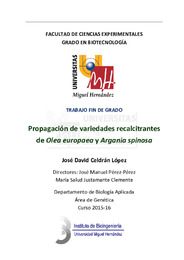Por favor, use este identificador para citar o enlazar este ítem:
https://hdl.handle.net/11000/3551
Propagación de variedades recalcitrantes
de Olea europaea y Argania spinosa
Título :
Propagación de variedades recalcitrantes
de Olea europaea y Argania spinosa |
Autor :
Celdrán López, José David |
Tutor:
Pérez Pérez, José Manuel
Justamante Clemente, María Salud |
Fecha de publicación:
2016-07-12 |
URI :
http://hdl.handle.net/11000/3551 |
Resumen :
El presente Trabajo Fin de Grado pretende contribuir a la optimización del protocolo
de micropropagación de las especies oleaginosas del argán (Argania spinosa (L.)
Skeels) y el olivo (Olea europea L.) con el fin de propagar variedades que puedan
resistir el futuro incremento de temperaturas y déficit hídrico a causa del cambio
climático, el cual tendrá un gran impacto en la Península Ibérica en los próximos años.
Hemos utilizado diferentes tratamientos con auxinas, tanto in vitro como in vivo, de
esquejes de estas especies oleaginosas para estudiar la formación de callo y de raíces
adventicias en 22 esquejes de argán in vitro, 115 esquejes de argán in vivo y 1248
esquejes de olivo in vivo. Con los parámetros morfológicos recopilados durante este
trabajo (formación del callo, número de raíces adventicias, número de hojas y longitud
de los esquejes), hemos llevado a cabo diversos estudios estadísticos basados en
análisis de varianzas para identificar qué tratamientos y qué parámetros influyen en
mayor manera en la formación de callo y aparición de raíces adventicias en dichos
esquejes.
Nuestros resultados indican que existen asociaciones estadísticamente
significativas en la formación de callo entre los tratamientos con auxinas y sin auxinas
en los esquejes de argán in vitro. Nuestros tratamientos con auxinas para los esquejes
de argán y olivo in vivo nos han permitido obtener raíces adventicias en esquejes de
ambas especies con una alta eficacia, y hemos observado diferencias estadísticamente
significativas en la obtención de callos y raíces adventicias y los diferentes
tratamientos con auxinas. Además, hemos encontrado correlaciones positivas entre
número de raíces y la formación de callo en los esquejes de argán in vivo y entre
formación de callo y número de hojas en esquejes de olivo in vivo. Nuestros
procedimientos permitirán aumentar la eficacia de la propagación vegetativa del olivo
y el argán.
This project aims to contribute to the optimization of micropropagation protocol of the
oleaginous species argan (Argania spinosa (L.) Skeels) and olive (Olea europaea L.) in
order to propagate varieties that can withstand the future rising temperatures and
rising shortages due to climate change, which will have a major impact on the Iberian
peninsula in the coming years. We have used different treatments with auxin, both in
vitro and in vivo, cuttings of these oleaginous species to study the formation of callus
and adventitious roots in 22 cuttings of argan in vitro, 115 cuttings of argan in vivo and
1248 cuttings of olive in vivo. With the morphological parameters collected during this
work (callus formation, adventitious root number, leaf number and length of cuttings),
we have carried out several statistical studies based on analysis of variance to identify
which treatments and what parameters have a major influence in callus formation and
development of adventitious roots in these cuttings.Our results indicate that there are statistically significant associations in callus
formation between treatments with auxin and without auxin in the cuttings of argan in
vitro. Our treatments with auxins for argan and olive cuttings in vivo have allowed us
to obtain adventitious roots in cuttings of both species with high efficiency, and we
have observed statistically significant differences in obtaining callus and adventitious
roots and the different treatments with auxin. In addition, we have found positive
correlations between the number of roots and callus formation in cuttings of argan in
vivo and between callus formation and leaf number in cuttings of olive in vivo. Our
procedures will increase the effectiveness of vegetative propagation of olive and
argan.
|
Palabras clave/Materias:
Auxinas
Argán
Olivo |
Área de conocimiento :
CDU: Ciencias puras y naturales: Biología: Bioquímica. Biología molecular. Biofísica |
Tipo documento :
application/pdf |
Derechos de acceso:
info:eu-repo/semantics/openAccess |
Aparece en las colecciones:
TFG - Biotecnología
|
 La licencia se describe como: Atribución-NonComercial-NoDerivada 4.0 Internacional.
La licencia se describe como: Atribución-NonComercial-NoDerivada 4.0 Internacional.
 La licencia se describe como: Atribución-NonComercial-NoDerivada 4.0 Internacional.
La licencia se describe como: Atribución-NonComercial-NoDerivada 4.0 Internacional.
.png)
